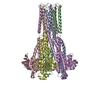+ Open data
Open data
- Basic information
Basic information
| Entry | Database: PDB / ID: 8ip3 | |||||||||||||||||||||||||||||||||
|---|---|---|---|---|---|---|---|---|---|---|---|---|---|---|---|---|---|---|---|---|---|---|---|---|---|---|---|---|---|---|---|---|---|---|
| Title | Cryo-EM structure of hMRS2-Mg | |||||||||||||||||||||||||||||||||
 Components Components | Magnesium transporter MRS2 homolog, mitochondrial | |||||||||||||||||||||||||||||||||
 Keywords Keywords | METAL TRANSPORT / pentamer | |||||||||||||||||||||||||||||||||
| Function / homology |  Function and homology information Function and homology informationmitochondrial magnesium ion transmembrane transport / Miscellaneous transport and binding events / magnesium ion transmembrane transporter activity / lactate metabolic process / transmembrane transport / mitochondrial inner membrane / mitochondrion Similarity search - Function | |||||||||||||||||||||||||||||||||
| Biological species |  Homo sapiens (human) Homo sapiens (human) | |||||||||||||||||||||||||||||||||
| Method | ELECTRON MICROSCOPY / single particle reconstruction / cryo EM / Resolution: 2.6 Å | |||||||||||||||||||||||||||||||||
 Authors Authors | Li, M. / Li, Y. / Yang, X. / Shen, Y.Q. | |||||||||||||||||||||||||||||||||
| Funding support |  China, 1items China, 1items
| |||||||||||||||||||||||||||||||||
 Citation Citation |  Journal: Nat Commun / Year: 2023 Journal: Nat Commun / Year: 2023Title: Molecular basis of Mg permeation through the human mitochondrial Mrs2 channel. Authors: Ming Li / Yang Li / Yue Lu / Jianhui Li / Xuhang Lu / Yue Ren / Tianlei Wen / Yaojie Wang / Shenghai Chang / Xing Zhang / Xue Yang / Yuequan Shen /  Abstract: Mitochondrial RNA splicing 2 (Mrs2), a eukaryotic CorA ortholog, enables Mg to permeate the inner mitochondrial membrane and plays an important role in mitochondrial metabolic function. However, the ...Mitochondrial RNA splicing 2 (Mrs2), a eukaryotic CorA ortholog, enables Mg to permeate the inner mitochondrial membrane and plays an important role in mitochondrial metabolic function. However, the mechanism by which Mrs2 permeates Mg remains unclear. Here, we report four cryo-electron microscopy (cryo-EM) reconstructions of Homo sapiens Mrs2 (hMrs2) under various conditions. All of these hMrs2 structures form symmetrical pentamers with very similar pentamer and protomer conformations. A special structural feature of Cl-bound R-ring, which consists of five Arg332 residues, was found in the hMrs2 structure. Molecular dynamics simulations and mitochondrial Mg uptake assays show that the R-ring may function as a charge repulsion barrier, and Cl may function as a ferry to jointly gate Mg permeation in hMrs2. In addition, the membrane potential is likely to be the driving force for Mg permeation. Our results provide insights into the channel assembly and Mg permeation of hMrs2. | |||||||||||||||||||||||||||||||||
| History |
|
- Structure visualization
Structure visualization
| Structure viewer | Molecule:  Molmil Molmil Jmol/JSmol Jmol/JSmol |
|---|
- Downloads & links
Downloads & links
- Download
Download
| PDBx/mmCIF format |  8ip3.cif.gz 8ip3.cif.gz | 290.2 KB | Display |  PDBx/mmCIF format PDBx/mmCIF format |
|---|---|---|---|---|
| PDB format |  pdb8ip3.ent.gz pdb8ip3.ent.gz | 233.1 KB | Display |  PDB format PDB format |
| PDBx/mmJSON format |  8ip3.json.gz 8ip3.json.gz | Tree view |  PDBx/mmJSON format PDBx/mmJSON format | |
| Others |  Other downloads Other downloads |
-Validation report
| Summary document |  8ip3_validation.pdf.gz 8ip3_validation.pdf.gz | 373.6 KB | Display |  wwPDB validaton report wwPDB validaton report |
|---|---|---|---|---|
| Full document |  8ip3_full_validation.pdf.gz 8ip3_full_validation.pdf.gz | 383.9 KB | Display | |
| Data in XML |  8ip3_validation.xml.gz 8ip3_validation.xml.gz | 29.5 KB | Display | |
| Data in CIF |  8ip3_validation.cif.gz 8ip3_validation.cif.gz | 40.4 KB | Display | |
| Arichive directory |  https://data.pdbj.org/pub/pdb/validation_reports/ip/8ip3 https://data.pdbj.org/pub/pdb/validation_reports/ip/8ip3 ftp://data.pdbj.org/pub/pdb/validation_reports/ip/8ip3 ftp://data.pdbj.org/pub/pdb/validation_reports/ip/8ip3 | HTTPS FTP |
-Related structure data
| Related structure data |  35630MC  8ip4C  8ip5C  8ip6C M: map data used to model this data C: citing same article ( |
|---|---|
| Similar structure data | Similarity search - Function & homology  F&H Search F&H Search |
- Links
Links
- Assembly
Assembly
| Deposited unit | 
|
|---|---|
| 1 |
|
- Components
Components
| #1: Protein | Mass: 51531.672 Da / Num. of mol.: 5 Source method: isolated from a genetically manipulated source Source: (gene. exp.)  Homo sapiens (human) / Gene: MRS2, HPT, MRS2L / Cell (production host): HEK-293F / Production host: Homo sapiens (human) / Gene: MRS2, HPT, MRS2L / Cell (production host): HEK-293F / Production host:  Homo sapiens (human) / References: UniProt: Q9HD23 Homo sapiens (human) / References: UniProt: Q9HD23#2: Chemical | ChemComp-CL / | #3: Chemical | ChemComp-MG / Has ligand of interest | N | Has protein modification | N | |
|---|
-Experimental details
-Experiment
| Experiment | Method: ELECTRON MICROSCOPY |
|---|---|
| EM experiment | Aggregation state: PARTICLE / 3D reconstruction method: single particle reconstruction |
- Sample preparation
Sample preparation
| Component | Name: human MRS2 / Type: COMPLEX / Entity ID: #1 / Source: MULTIPLE SOURCES |
|---|---|
| Molecular weight | Value: 0.25 MDa / Experimental value: NO |
| Source (natural) | Organism:  Homo sapiens (human) Homo sapiens (human) |
| Source (recombinant) | Organism:  Homo sapiens (human) / Cell: HEK-293F Homo sapiens (human) / Cell: HEK-293F |
| Buffer solution | pH: 8 Details: 20 mM Tris-HCl pH 8.0, 150 mM NaCl, 20 mM MgCl2, 0.007% (w/v) glycol-diosgenin and 1 mM DTT |
| Specimen | Conc.: 10 mg/ml / Embedding applied: NO / Shadowing applied: NO / Staining applied: NO / Vitrification applied: YES |
| Specimen support | Grid material: GOLD / Grid type: Quantifoil |
| Vitrification | Instrument: FEI VITROBOT MARK IV / Cryogen name: ETHANE / Humidity: 100 % / Chamber temperature: 281 K |
- Electron microscopy imaging
Electron microscopy imaging
| Experimental equipment |  Model: Titan Krios / Image courtesy: FEI Company |
|---|---|
| Microscopy | Model: FEI TITAN KRIOS |
| Electron gun | Electron source:  FIELD EMISSION GUN / Accelerating voltage: 300 kV / Illumination mode: FLOOD BEAM FIELD EMISSION GUN / Accelerating voltage: 300 kV / Illumination mode: FLOOD BEAM |
| Electron lens | Mode: BRIGHT FIELD / Nominal defocus max: 1600 nm / Nominal defocus min: 800 nm / Alignment procedure: COMA FREE |
| Specimen holder | Cryogen: NITROGEN / Specimen holder model: FEI TITAN KRIOS AUTOGRID HOLDER |
| Image recording | Electron dose: 59.97 e/Å2 / Film or detector model: FEI FALCON IV (4k x 4k) / Num. of grids imaged: 1 / Num. of real images: 3329 |
- Processing
Processing
| EM software |
| ||||||||||||||||||||||||
|---|---|---|---|---|---|---|---|---|---|---|---|---|---|---|---|---|---|---|---|---|---|---|---|---|---|
| CTF correction | Type: NONE | ||||||||||||||||||||||||
| Particle selection | Num. of particles selected: 473653 | ||||||||||||||||||||||||
| Symmetry | Point symmetry: C1 (asymmetric) | ||||||||||||||||||||||||
| 3D reconstruction | Resolution: 2.6 Å / Resolution method: FSC 0.143 CUT-OFF / Num. of particles: 304325 / Symmetry type: POINT | ||||||||||||||||||||||||
| Atomic model building | Protocol: AB INITIO MODEL / Space: REAL | ||||||||||||||||||||||||
| Refine LS restraints |
|
 Movie
Movie Controller
Controller






 PDBj
PDBj




